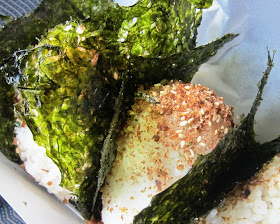The tiny little store Sunny Blue is on Santa Monica's Main Street - a hippy, trendy yet still a little funky stretch of stores just blocks from the beach.
Like many small - even micro - businesses, Sunny Blue has figured out how to concentrate on doing something simple and doing it well. Sunny Blue has two products for sale. Frozen yogurt, and Omusubi, Japanese rice balls.
 |
| 3 omusibi nestled in a carry-out basket |
The ease and versatility of them has made them popular in other Asian urban communities, including Hong Kong, Taiwan, South Korea and even Hawaii. Up until now, they were rare in the US. Here in Santa Monica, where we have many Japanese tourists visiting, I've seen them in the refrigerator case of the Famima! convenience store, but Sunny Blue on Main Street is the first store in Southern California dedicated to making fresh omusubi like they do in Japan.
Japanese moms make omusubi for their kids' lunchboxes, too, and here at Sunny Blue the woman in charge has a motherly air as she molds your omusubi to order.
I went in one day for lunch, and ordered Sunny blue's futatsu special - two rice balls plus a choice of one side with pickles. I chose a miso beef filling for one, and for the other, albacore tuna with mustard and chopped green onions. I got a little container of cucumber sunumono and another of Japanese pickles called tsukemono.
When I received my order, I discovered they'd rung me up for three omusubi instead - a double order of miso beef. I started to return the extra one, but it seemed hard to turn back something that had been made by hand just for me.I kept it.
The little store is too tiny for seating, with only a trio of stools at a wee counter, and a couple of wire tables and chairs out front, so I went out on the sidewalk.
The little paper basket was warm and heavy in my hand. I stopped at the spindly little table out front and took a tentative bite from one. I didn't even know which one it was. A dusting of furikake garnished the top, lending a salty, nutty savory taste even before I got to the filling within.
I'd eaten convenience food omusubi before, cold from the refrigerator case, with the nori wrapped separately so it wouldn't get soggy. But these were different. They were warm, and so was the nori, crispy, melting into softness in my mouth. Ooh, delicious!
At the office I shared my extra omusubi with a co-worker. The filling was great, a slow-cooked tender meatiness rich with the umami funk of miso. The tuna and mustard filling was perhaps a little too piquant for my taste, although I think I'd like to try it again paired with something less mellow than the beef.
The sunemono was more sour than sweet, which is different from what I'm used to, but they used small fresh cucumbers and marinated bitter greens that were tasty. The tsukemono pickles were deep purple and puckery good, and I have no idea what vegetable I was eating.
All I knew was, I wanted more.
 |
| Saturday morning a young man makes omusubi at Sunny Blue |
I came back with [The Man I Love] and we each ordered a combo. This time, on a weekend, the tiny store was packed. Typical Santa Monica yoga moms and soccer dads stood in line with their kids. For the holidays, the place was decked out with garlands of plastic cup covers decorated with colorful markers and designs, candy canes, and dangling packages of Japanese snacks.
While we waited for our order, I stood by the glass divider and watched them mold the omusubi. It's done completely by hand. The rice is portioned onto a sheet of plastic. A filling of chopped vegetables or pickles might be mixed with the rice, or a dimple is pushed into the rice to hold a gravy-like filling. Then the plastic-enclosed rice is patted and squeezed into a triangular shade, and released onto a sheet of nori, which, folded around it, is nestled into the paper box. Dash with a topping of sesame seeds, furukake, or chopped herbs - that's it.
We took our paper baskets down the street to eat off the top of our parked car. He had the miso beef and a vegan combination called Wasabi Tsukudani, fresh pickled wasabi and pickled konbu, which is kelp. I chose their Tokyo Tori, with chicken in sweet-and-sour sauce, and Lucky Cat, with pickles, bonito flakes, ginger and wasabi.
 |
| Gobo and carrot |
For sides we ordered kim chee, but alas, it was out. Instead, we tried pickled gobo, or burdock root, tossed with carrots in a slightly sweet vinegary dressing. We also had the special side, marinated chrysanthemum leaves, which had a bold, bitter, assertive taste.
 |
| Lucky Cat omusubi |
Omusubi are so simple that you could easily make them at home, following directions you can find HERE. But I think there's something nice about getting them warm and right from the hands of people who care about giving you a good and nutritious lunch. I've found a new place to have lunch!




You never fail to inspire me to try new foods. Using the top of your car for a picnic table is a nice touch, too.
ReplyDeleteI spy Pikachu!
How did you like the gobo?
ReplyDeleteIt sounds like a nice combination of tastes.
~
I seriously think you should give culinary tours of LA. These look so good.
ReplyDelete